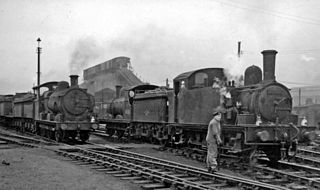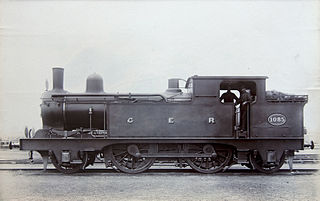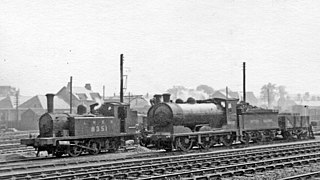
The NBR C Class is a class of 0-6-0 steam locomotive designed by Matthew Holmes for freight work on the North British Railway. They were introduced in 1888 and had inside cylinders and Stephenson valve gear. A total of 168 locomotives was built, of which 123 came into British Railways ownership at nationalisation in 1948. This was the last class of steam engine in service in Scotland.

The NBR K class is a class of 4-4-0 steam locomotive of the North British Railway. The first batch was designed by Matthew Holmes in 1902 and had 6-foot-6-inch (1.981 m) driving wheels for express passenger work. Three more batches were designed by William P. Reid with 6-foot-0-inch (1.829 m) driving wheels for mixed traffic work. This included perishable goods, such as fish from Mallaig and Aberdeen. They had inside cylinders and Stephenson valve gear. The D34 locomotives, commonly known as Glen Class, were built with superheaters. The LNER later fitted superheaters to all D26, D32, and D33 engines as well. All engines of the K class are sometimes known as Glen Class, although the designation is strictly reserved to the fourth (D34) batch.

The North Eastern Railway (NER) Class H, classified as Class Y7 by the London and North Eastern Railway (LNER) is a class of 0-4-0T steam locomotives designed for shunting.
The NBR Class M was a class of 4-4-0 steam locomotive of the North British Railway. The class was created during the tenures of William P. Reid and Walter Chalmers by rebuilding three earlier types, the "574", "633", and "729", which had all been designed by Matthew Holmes, and shared many features in common. A total of 48 were produced.

The NBR J Class , commonly known as the Scott class, were a class of 4-4-0 steam tender locomotives designed by William P. Reid for the North British Railway. They passed to the London and North Eastern Railway at the grouping in 1923. Forty-three were built, of which thirty-five survived into British Railways ownership in 1948.
The LD&ECR class A was a class of 0-6-2T steam locomotives of the Lancashire, Derbyshire and East Coast Railway. An initial batch of eight was ordered and built in 1895. An order for 15 more was placed in 1899 but five of these were not delivered because the LD&ECR was unable to pay for them. The undelivered locomotives were re-sold by Kitson & Co. to the Hull and Barnsley Railway and became H&BR Class F1. There are some detail differences between the LD&ECR class A and the H&BR Class F1 but these were the result of later modifications.

The GER Class C72 was a class of thirty 0-6-0T steam locomotives designed by A. J. Hill for the Great Eastern Railway. They passed to the London and North Eastern Railway (LNER) at the 1923 grouping and received the LNER classification J68.

The NBR 224 and 420 Classes consisted of six steam locomotives of the 4-4-0 wheel arrangement built by the North British Railway (NBR) in 1871 and 1873. No. 224 had three claims to fame: it was the first inside-cylinder 4-4-0 engine to run in Great Britain; it was the locomotive involved in the Tay Bridge disaster; and after rebuilding in 1885, it was the only compound-expansion locomotive on the NBR, and one of just three tandem compounds in Britain.

The GER Class T77 was a class of twenty-five 0-6-0 steam locomotives designed by A. J. Hill for the Great Eastern Railway. They all passed to the London and North Eastern Railway at the 1923 grouping and received the classification J19.

The GER Class G69 was a class of twenty 2-4-2T steam locomotives built by for the Great Eastern Railway by S. D. Holden in 1911–12 following the design of two rebuilt examples of the GER Class M15 designed by James Holden, his father, in 1904. They all passed to the London and North Eastern Railway at the 1923 grouping and received the classification F6.

The NBR S Class is a class of 0-6-0 steam locomotive designed by William Paton Reid for freight work on the North British Railway. The engines were initially designated as B class, being a development of the standard B class locomotives designed by Reid some eight years previously, and represented the culmination of a long evolution on the NBR of powerful 0-6-0 freight engines. The new locomotives were introduced in 1914 and had superheaters, inside cylinders and piston valves operated by Stephenson valve gear.

The NER B and B1 Classes were two classes of 0-6-2 tank locomotives designed by Thomas William Worsdell for heavy freight and mineral on the North Eastern Railway, introduced in 1886. They were tank engine versions of the NER C1 Class 0-6-0, using both simple expansion and also the von Borries configuration for two-cylinder compound locomotives. Both types were later rebuilt using saturated steam and the compounds were also rebuilt as simple expansion locomotives, and eventually formed a single class. Many of the superheated locomotives were also later returned to saturated steam as their original boilers wore out. As a result the classes have had a very complex history mechanical history.
The NBR 141 Class consisted of two steam locomotives of the 2-4-0 wheel arrangement built by the North British Railway (NBR) in 1869. They were the direct antecedents of the NBR 224 Class 4-4-0.
The NER Class U was a class of 0-6-2 tank locomotives of the North Eastern Railway. It was designed by Wilson Worsdell and introduced in 1902.
The GER Class Y65 was a class of twelve 2-4-2T steam locomotives designed by S. D. Holden and built by the company's Stratford Works in 1909–1910. They all passed to the London and North Eastern Railway at the 1923 grouping and received the classification F7.

The GER Class C32 was a class of fifty 2-4-2T steam locomotives designed by James Holden and built by the company's Stratford Works between 1892 and 1902. They all passed to the London and North Eastern Railway at the 1923 grouping and received the classification F3.

The North British Atlantic, later known as NBR Class H, and then as LNER Class C11 was a class of 4-4-2 steam locomotive of the North British Railway. The class was designed by William P. Reid, Locomotive Superintendent of the NBR, and entered service under his direction. They were the heaviest, longest, and most powerful locomotives ever employed on the North British Railway.

The NBR Class N was a class of 4-4-0 steam locomotive of the North British Railway. The class was designed by Matthew Holmes and later rebuilt by Holmes's successor, Reid. A total of 12 were produced.
The NBR Class D was a class of 0-6-0 steam locomotive of the North British Railway, often known as the Wee Drummonds. The class was designed by Dugald Drummond. A total of 101 were produced.

The NBR F Class was a class of 0-6-0 tank locomotives, designed by William P. Reid on the North British Railway. They were used for dockyard shunting duties.














